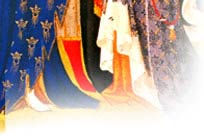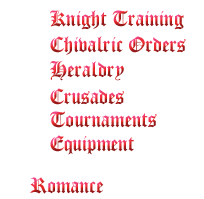 |
|||
  

|
Training a Knight Becoming a page was usually the first step most took in the path to knighthood. Training began at a very young age. At 7, the son of a medieval nobleman or knight would be sent off to serve as a page in a lord's castle. There, he would learn horsemanship, archery and swordsmanship, and perform various other duties around the castle. Squires would begin training as early as 10 years, but the majority would be attached to a knight for training at age 14. A squire's training concentrated on strength, fitness and skill with various weapons. Individual training was only part of the regimen, as knights also needed to know how to fight as part of a team of skilled horsemen. The squire would care for the knight's horse, clean the stables, polish the knight's armor and maintain his weapons. They would learn the chivalric codes of conduct and listen to epic tales of Roland, Charlemagne, Arthur, Percival and Lancelot. After years of training, and usually around the age of 21, the squire would go through the dubbing ceremony. In the early Middle Ages, this was simply done with a brief, open-handed blow to the neck followed by an admonition to conduct himself with courage, bravery, skill and loyalty. After the 11th century, the Church expanded this ceremony to incorporate seeds of religious chivalry-needed to fight the Crusades-and promised in return, they would be guaranteed a place in heaven for their loyalty. The dubbing ceremony became much more elaborate during the 11th and 12th centuries. Some would pray alone in church the night before the ceremony, wearing simple clothes to prove humility before God. The priest would bless his sword, and when presented, the new knight would kiss the hilt, which often contained religious relics. |
 |
|
 |
|||
 |
|||